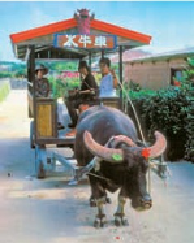Travel Reference
In-Depth Information
a fair number are employed in the operation of a large cattle ranch occupying the southern
one-third of the island or work on a commercial shrimp farm, also in the southern part of
Taketomi.
Transportation around Taketomijima is by water buffalo cart, by bicycle or on foot.
Taketomi Island is famous for being one of Okinawa's best preserved places and for this
reason it has been designated a Japanese National Treasure. You only have to spend a few
minutes on the island to see why. In its traditional Ryukyuan village, which is the only village
(
集落
;
shūraku
) on the island, there are no buildings permitted over one story high. Hence,
all the houses (a number of which are
minshuku
) and shops have the ambience of an ancient
small town. In addition, the buildings must employ the traditional Okinawan red-, white- or
orange-tiled roof. And, naturally, though it might not be required, you won't find a rooftop
that does not sport a
shīsā
lion dog on top, some of which are quite imaginative.
You won't find any ugly cinder block or cement walls here either; they're not allowed.
Rather, most houses have their surrounding walls fashioned of hand-cut coral stone, the way
it's been for centuries. The town lanes are of similar construction and are usually festooned
with blooming hibiscus, bougainvillea or other flowering plants. The streets? No common
hot ugly black asphalt, pavement or cement will do. Here it is white coral dust and sand, hard-
packed over the years by many feet. Transportation around the island is by water buffalo cart
(
水牛車
;
suigyū-sha
). Bicycles may also be rented, or you can walk. After all, nothing is too
far.
Taketomi village has a tiny “downtown,” the remnants of an ancient public well, an ele-
mentary and junior high school, a post office and a viewing tower called Nagaminoto, the
biggest tourist “sight” on the island.

